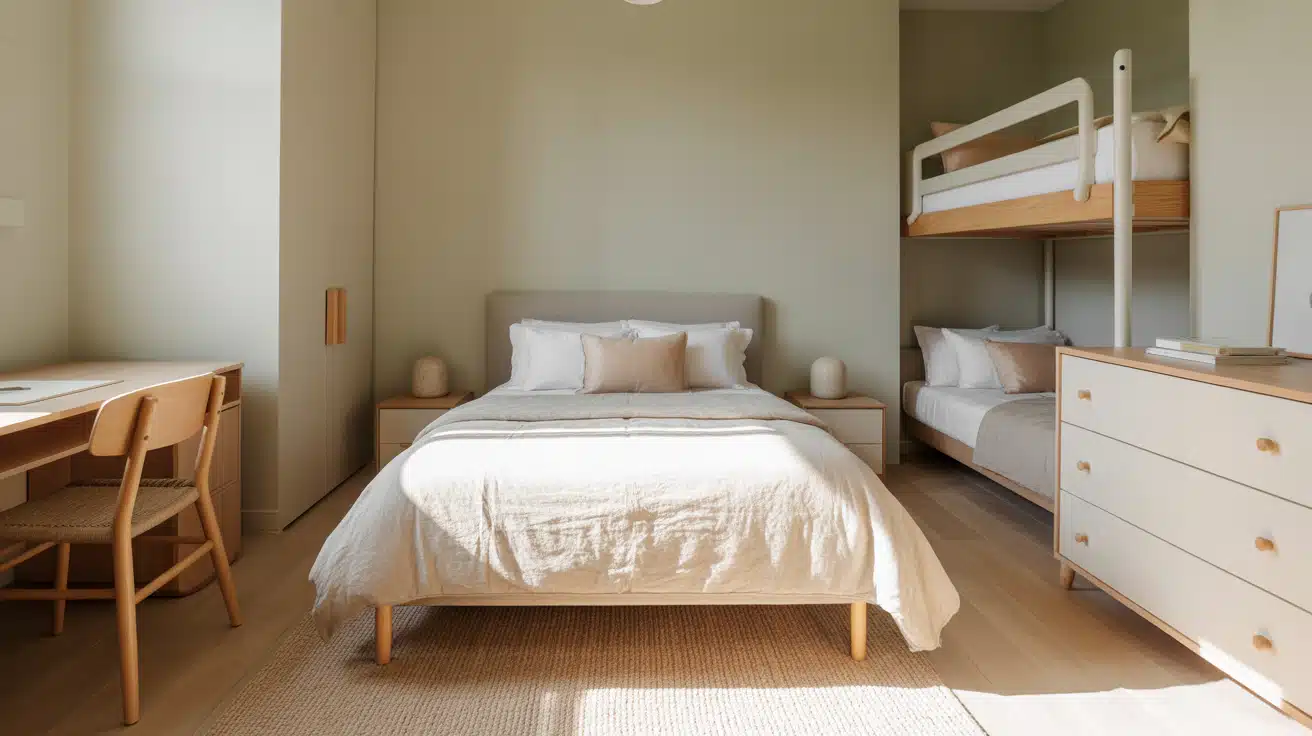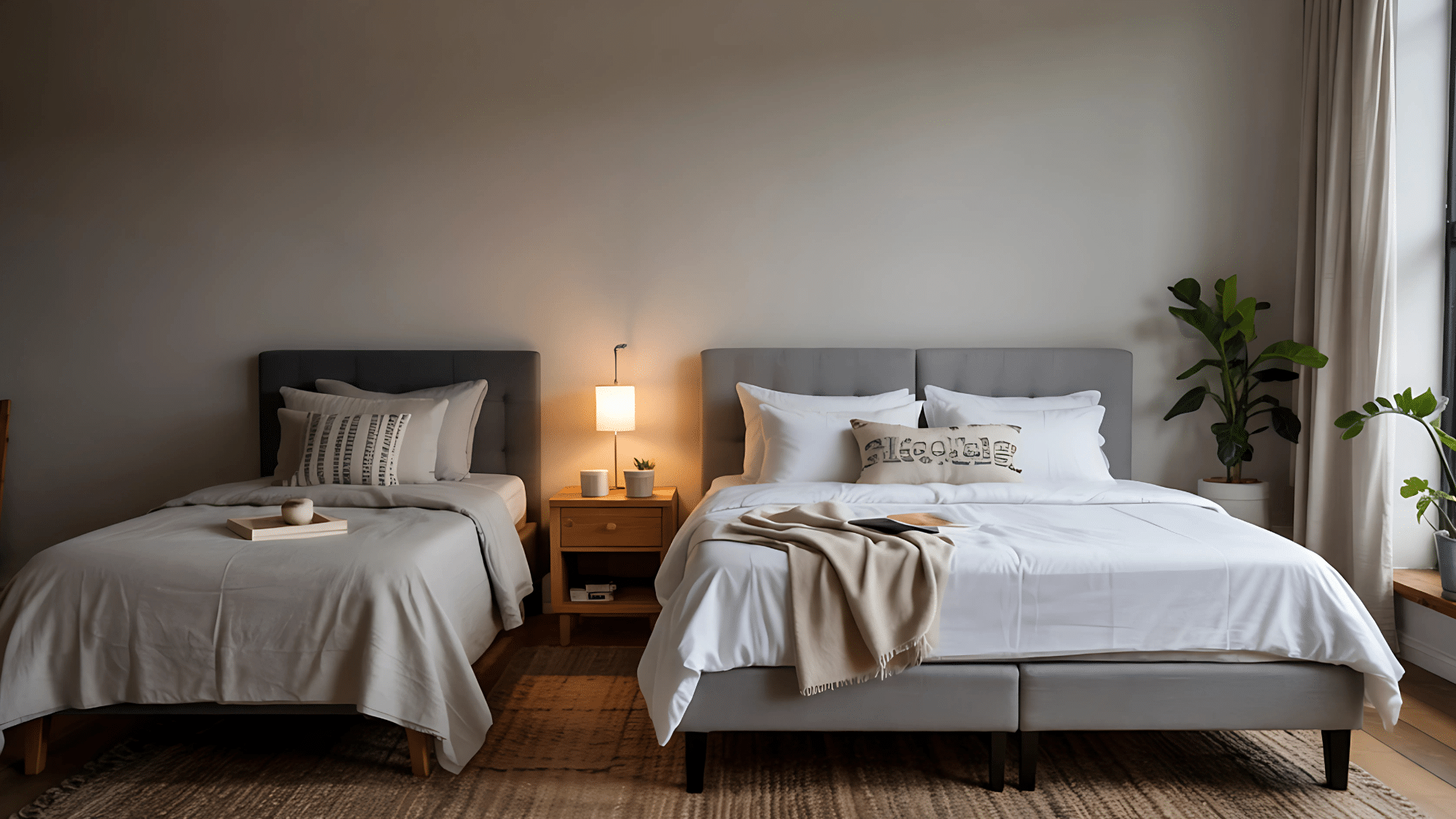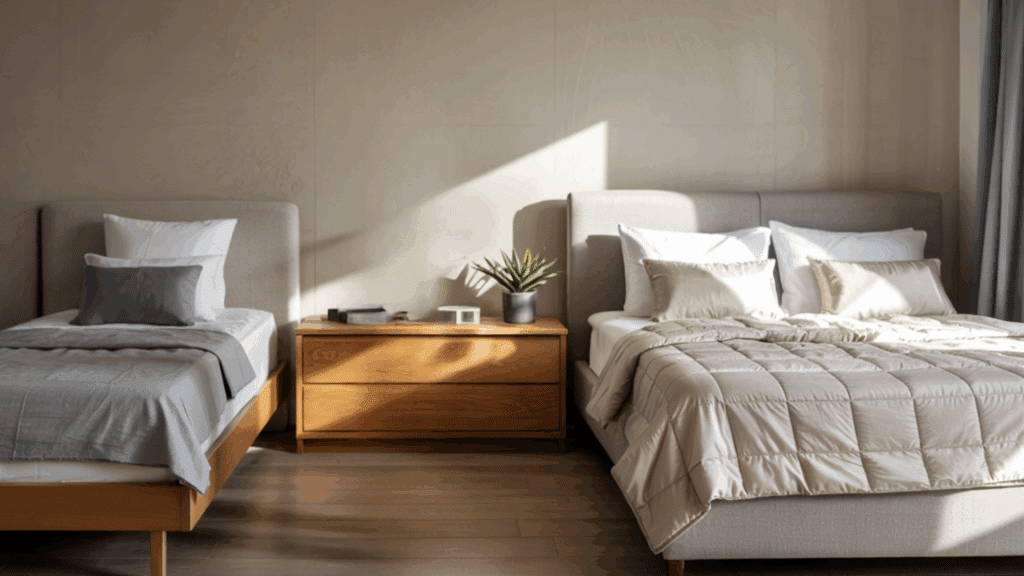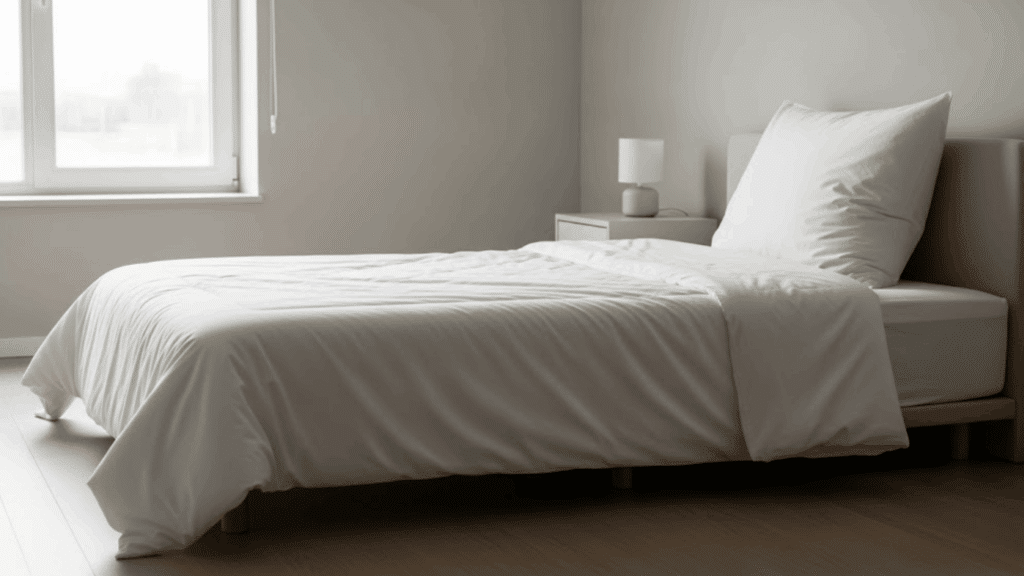Ever stood in a mattress store feeling completely lost? You’re not alone.
Choosing between a twin and a full mattress shouldn’t be rocket science. But when you’re staring at rows of beds, they all start looking the same.
Here’s what matters most. Size really affects your sleep quality. Too small means tossing and turning all night. It’s too big, wasting money and precious bedroom space.
Twin mattresses work well for kids and tight spaces. Full beds give adults room to actually move around. But there’s more to think about than just measurements.
This guide breaks down everything you need to know. No confusing terms or pushy sales talk. Just straight facts to help you pick the right mattress for your space and budget.
Twin vs Full Mattress Comparison Chart
Making the right mattress choice starts with understanding the fundamental differences between these two popular sizes. The following comparison highlights the key specifications and considerations that will impact your decision.
| FEATURE | TWIN MATTRESS | FULL MATTRESS |
|---|---|---|
| Dimensions | 38″ × 75″ | 54″ × 75″ |
| Surface Area | 19.8 sq ft | 28.1 sq ft |
| Best For | Kids, singles, small spaces | Adults want more room |
| Weight Capacity | Up to 250 lbs | Up to 400 lbs |
| Price Range | $150-$800 | $200-$1,200 |
| Room Size Needed | 7′ × 10′ minimum | 10′ × 12′ minimum |
| Sheet Cost | Most affordable | Moderate pricing |
| Moving Difficulty | Easy (40-60 lbs) | Moderate (60-80 lbs) |
This side-by-side breakdown reveals that while full mattresses cost more upfront, they provide significantly more sleeping space and better long-term value.
Consider these specifications carefully as you evaluate which size aligns with your specific needs and living situation.
Twin Mattress: Complete Overview

Twin mattresses represent the most compact standard bed size, measuring 38″ × 75″ and designed primarily for single sleepers. Understanding both the advantages and limitations of twin beds helps you determine if this size fits your specific needs and living situation.
Benefits of Twin Mattresses
Twin mattresses offer several compelling advantages that make them the right choice for specific situations and users.
- Space Efficiency: Twin beds excel in small bedrooms, studio apartments, and shared spaces where maximizing floor area is crucial. Their compact 38″ × 75″ footprint leaves plenty of room for desks, dressers, and play areas.
- Budget-Friendly: These mattresses typically cost $100-400 less than full-size options, making them ideal for families furnishing multiple children’s rooms or budget-conscious shoppers.
- Easy Handling: Weighing only 40-60 pounds, most adults can move twin mattresses alone during room rearrangements or relocations without requiring help.
- Flexible Configurations: Twin beds work perfectly for bunk beds, trundle setups, and daybed frames, offering adaptability in smaller homes and shared bedrooms.
Twin mattresses provide excellent value for specific situations and users. Their compact size and affordability make them a practical choice for many households.
Drawbacks of Twin Mattresses
Despite their advantages, twin mattresses have limitations that may affect long-term satisfaction. Adults taller than 5’8″ often find them cramped, with feet hanging over the edge and limited room for comfortable movement during sleep.
Children typically outgrow them by age 10-12, requiring earlier replacement compared to larger sizes that accommodate growth spurts. Twin beds cannot accommodate couples or pets comfortably, limiting their functionality for changing life situations.
The smaller market for used twin mattresses can also make reselling more difficult when upgrading to larger sizes.
Consider these limitations carefully when evaluating twin mattresses for your situation. While they offer clear benefits for specific users, the drawbacks may impact long-term satisfaction and value.
Full Mattress: Complete Overview

Full mattresses measure 54″ × 75″ and provide significantly more sleeping space than twin options. Their increased width makes them suitable for adults, teenagers, and anyone who values extra room for comfortable sleep and movement.
Benefits of Full Mattresses
Full mattresses provide improved comfort and adaptability that make them suitable for a broader range of users and situations.
- Generous Sleep Space: The 54″ width offers ample room for single adults to stretch, change positions, and sleep comfortably without feeling confined.
- Long-Term Value: Full mattresses accommodate users from teenage years through adulthood, providing 8-10 years of use without size-related replacement needs.
- Occasional Sharing: While not ideal for couples long-term, full beds can accommodate two people occasionally for guests or temporary situations.
- Adult Comfort: The extra 16 inches of width makes a significant difference for restless sleepers, pet owners, and anyone who enjoys reading or working in bed.
Full mattresses offer substantial comfort improvements over smaller options. Their increased size provides better accommodation for various sleeping styles and life changes.
Drawbacks of Full Mattresses
Full mattresses require more consideration regarding space and budget constraints. Initial investment runs $200-500 more than twin options, with ongoing expenses for larger bedding and accessories also increasing overall costs.
Full beds need larger bedrooms (minimum 10′ × 12′) and may overwhelm smaller spaces or leave insufficient room for other furniture. Weighing 60-80 pounds and measuring 54″ wide, full mattresses require two people for safe transport and may not fit through narrow doorways easily.
Young kids under 8 may feel lost in the larger space, and the extra size doesn’t provide practical benefits for their sleeping habits.
These drawbacks primarily relate to space and budget considerations rather than sleep quality. Check your room size and financial situation carefully before committing to a full mattress.
Key Differences Between Twin vs. Full Mattresses

Understanding the specific differences between twin and full mattresses helps clarify which option best suits your needs. These key factors go beyond basic size to include practical considerations that affect daily use and long-term satisfaction.
1. Size and Dimensions
The most obvious difference lies in the measurements themselves. Twin mattresses measure 38″ × 75″, while full mattresses expand to 54″ × 75″. This 16-inch width difference translates to 8.3 additional square feet of sleeping surface, which significantly impacts comfort levels for most sleepers.
The length remains identical at 75 inches, so both sizes accommodate most adults without length-related issues. However, very tall individuals (over 6’2″) might consider twin XL or full XL options for extra legroom.
2. Room Requirements and Layout Impact
Space planning becomes crucial when choosing between these sizes. Twin beds work in bedrooms as small as 7′ × 10′, leaving adequate walking space and room for essential furniture like dressers or desks.
Full mattresses require minimum room dimensions of 10′ × 12′ to avoid a cramped feeling. In smaller spaces, full beds can dominate the room and limit furniture placement options, making the space feel cluttered rather than cozy.
3. Weight Capacity and Durability
Structural differences affect how much weight each mattress can safely support. Twin mattresses typically handle up to 250 pounds, making them suitable for children and lighter adults but potentially limiting for heavier users.
Full mattresses offer higher weight capacities of up to 400 pounds due to their larger support structure and additional materials. This increased durability often translates to longer lifespan and better performance over time.
4. Cost Considerations
The price gap extends beyond the initial mattress purchase. Twin mattresses generally cost $100-400 less than comparable full-size models, with entry-level options starting around $150 compared to $200 for full beds.
Ongoing costs include bedding, where twin sheets cost $15-30 while full sheets range $25-50. Bed frames, mattress protectors, and other accessories also scale with size, creating cumulative savings with twin options.
5. Sleeping Comfort and Space
The comfort difference becomes apparent during actual use. Twin beds provide adequate space for children and petite adults, but can feel restrictive for average-sized adults who prefer room to move during sleep.
Full mattresses offer the freedom to change positions without feeling confined. The extra width accommodates different sleeping styles, allows for pets or occasional sharing, and provides space for activities like reading before bed.
6. Longevity and Adaptability
Twin mattresses serve immediate needs well, but may require replacement sooner as children grow or life situations change. Most kids outgrow twin beds by age 10-12, necessitating an upgrade during their teenage years.
Full mattresses adapt to changing needs more effectively. They work for teenagers, college students, young adults, and can even serve as guest beds for couples when needed, providing better long-term value despite higher upfront costs.
Should You Get a Twin or Full Mattress?

Making the right mattress choice requires an honest assessment of your space, budget, and sleeping needs. Consider both immediate requirements and future changes when weighing these two options.
- Choose a twin mattress: If you’re furnishing a child’s room, working with a tight budget, have space limitations, or need multiple beds. Twin beds work well for guest rooms and temporary situations.
- Choose a full mattress: If you’re buying for a teenager or adult, want long-term use, have adequate space, or prioritize comfort over cost. Full beds work better for restless sleepers and pet owners.
- Consider your timeline: When deciding for growing children, consider the trade-off between replacement costs and the longevity of a full bed. Room layout matters, so measure carefully and consider furniture placement.
The right choice balances immediate needs with long-term comfort and practicality.
Conclusion
Choosing between twin and full mattresses comes down to your space, budget, and sleep needs.
Twin beds work well for children, small rooms, and tight budgets, while full mattresses provide improved comfort for adults and changing needs.
Both sizes offer good value when matched to the right situation. Twin mattresses save money upfront, while full beds cost more initially but provide improved long-term flexibility and comfort.
The key is being honest about your current space and future requirements.
Measure your room carefully, consider who will be sleeping, and factor in total costs, including bedding and frames, for improved sleep quality.
Ready to find your ideal mattress size? Start shopping with confidence using these guidelines.





